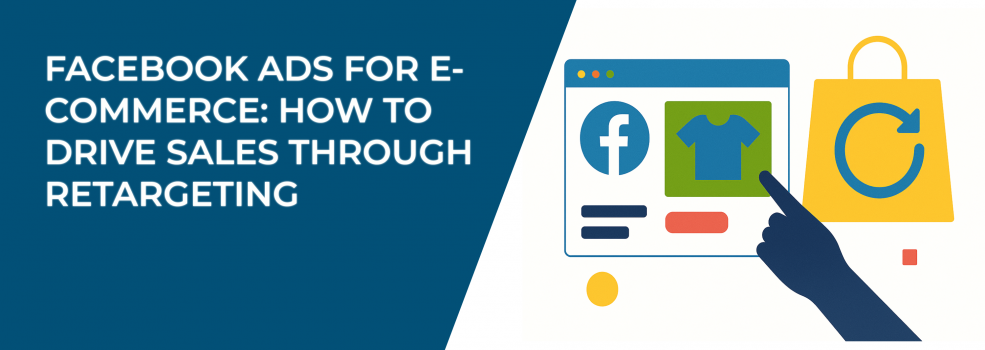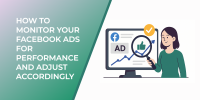When someone visits your online store, adds something to their cart, and leaves without buying — it’s frustrating. You’ve done the hard part. You got them interested. But then, nothing.
Retargeting with Facebook Ads helps you follow up. It’s a way to reach people who already know your brand and remind them why they clicked in the first place.
In this article, we’ll walk through how retargeting works, why it’s especially useful for e-commerce businesses, and how to set it up in a way that actually leads to more sales.
Why retargeting works so well for E-Commerce
Most people won’t buy on their first visit. That’s normal. They might be comparing prices, checking reviews, or just browsing.
But if they’ve already clicked on one of your products or started the checkout process, they’re interested — even if they didn’t buy yet.
Retargeting helps you stay in front of these people while they’re still thinking. You’re not trying to convince someone new. You’re following up with someone who’s already halfway there.
Here’s what makes retargeting especially useful:
-
You’re talking to warm leads; these aren’t random users — they’ve shown interest;
-
You can tailor the message; show the exact product they looked at or a reminder about their abandoned cart;
-
It’s more efficient; you spend money on people more likely to buy, not just anyone scrolling.
These advantages give retargeting a strong edge over broader campaigns. It’s focused, budget-friendly, and deeply tied to real behavior — not just demographics or interests. Let's check how to do that.
Step 1: Set up the Meta Pixel (if you haven’t already)
The Meta Pixel is a bit of code you add to your website. It tracks actions like page views, product clicks, and purchases.
Once it’s in place and working, you can use that data to create Custom Audiences in Ads Manager — groups of people based on what they did on your site.
Start by setting up these basic audience groups:
-
Viewed a product but didn’t add to cart. These users showed interest, but didn’t go very far — try reminding them what they saw;
-
Added to cart but didn’t purchase. This group is very close to buying — a small nudge (like free shipping or a limited-time offer) can help them finish;
-
Visited key pages (like your homepage or category pages). They’re browsing, but haven’t gone deeper — show them best-sellers or customer reviews to build trust;
-
Past customers. You can retarget them with related items or restocks.
These segments help you tailor your message based on where someone left off. You don’t need to guess — their actions tell you what they care about.
Don’t wait too long to retarget. If someone visited your store a month ago and hasn’t come back, chances are they’ve moved on. Try to stay within a 3–14 day window for best results.
If you’re not sure how to install the Meta Pixel or create custom retargeting audiences, this step-by-step guide on setting up Facebook retargeting will walk you through it in detail.
Step 2: Make your ads personal, not pushy
Retargeting ads should feel like a helpful reminder, not like you're following someone around the internet.
Think about what the person might need to see to come back. Is it a product detail they missed? A better image? A review? A discount?
Here’s what to keep in mind when creating your ads:
-
Use clear, direct messages, like “Still thinking about this?” or “You left this in your cart”;
-
Show the exact product. Dynamic Product Ads (DPAs) do this automatically — you set them up once, and they adjust based on what the user viewed;
-
Make the benefit clear, especially if you’re offering something like free shipping, easy returns, or a discount;
-
Keep the visuals clean. Don’t overcrowd the image — let the product stand out.
You don’t need to write long paragraphs. Often, a well-placed image and one sharp line are enough to bring someone back.
Let’s say someone looked at a backpack on your site. You could run an ad that shows that exact backpack, along with a few customer reviews and a message like “This one’s almost gone — don’t miss it.”
Step 3: Avoid overdoing it
One of the biggest mistakes with retargeting is showing the same ad over and over. That doesn’t make people want to buy — it makes them want to hide your ad.
Keep things fresh and avoid annoying your audience by:
-
Changing the ad creative every 1–2 weeks. Switch up the image, headline, or message to keep it interesting;
-
Watching your ad frequency. If people are seeing your ad more than 5–6 times and still not clicking, it’s time to try something new;
-
Using time-based audiences. Show a different ad to someone who visited yesterday versus someone who visited two weeks ago. For example:
-
Days 1–3: “Forgot something?”;
-
Days 4–7: “Here’s 10% off — just for you.”;
-
Days 8–14: “Last chance — this product’s almost gone.”;
-
-
Excluding people who already purchased. If they already bought, don’t keep pushing the same product — instead, suggest something they might like next.
These adjustments help you avoid what most people hate about ads: repetition. Good retargeting should feel like a natural follow-up, not a copy-paste.
Not sure if your ads are getting stale? This guide to spotting and fixing Facebook ad fatigue breaks it down clearly.
Step 4: Think beyond abandoned carts
While abandoned carts are a great place to start, retargeting can do more than just chase unfinished checkouts.
Here are other smart ways to use it:
-
Re-engage Instagram followers who haven’t visited your site; these people already like your content — invite them to shop;
-
Promote new arrivals to past buyers; if someone bought workout clothes last month, they might be interested in new gear;
-
Run seasonal reminders; did they buy a winter coat last year? Let them know about the new collection this year;
-
Encourage reviews or referrals; after a purchase, follow up with an ad that says “How did you like your order?” or “Share with a friend and get a discount.”
These aren’t just nice ideas — they’re ways to build long-term customer relationships. Retargeting isn’t only about finishing a sale; it’s also about staying top of mind over time.
Step 5: Track results and adjust
Once your campaigns are running, check in often. Look at what’s working and what’s not. Facebook Ads Manager gives you data like:
-
Click-through rate (CTR);
-
Conversion rate;
-
Cost per result;
-
ROAS (return on ad spend).
Don’t stop there — break it down by audience. For example:
-
Which audiences are converting? Maybe cart abandoners convert at a high rate, but product viewers don’t — focus your budget where it counts;
-
Are some ads underperforming? Pause the ones with low CTR or high costs. Try something different — maybe a video, or a new offer;
-
Are your sales being properly tracked? Use UTM tags in your links and check Google Analytics too, just to make sure nothing is being missed.
Getting into the habit of reviewing performance weekly (or even twice a week) can help you avoid wasting budget. The goal isn’t to run perfect ads — it’s to keep improving them.
If you’re seeing clicks but no purchases, here’s what to check when your Facebook ads aren’t converting.
Final thoughts
Retargeting with Facebook and Instagram ads is one of the simplest ways to increase e-commerce sales. It works because you’re talking to people who already know what you sell — you’re just helping them take the next step.
But to make it work well, you need to keep it relevant, fresh, and respectful of your audience’s time and attention. When your ads feel useful rather than repetitive, they’ll be more likely to drive results.

